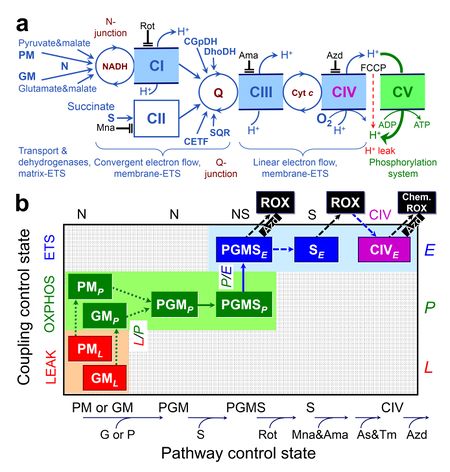Gnaiger 2017 Abstract MitoEAGLE Barcelona
|
Quality first: a paradigm shift in mt-respiratory control towards global connection. |
Link: MitoEAGLE
Gnaiger E (2017)
Event: MitoEAGLE Barcelona 2017
Few fields of basic science have experienced a reputation of fierce competition comparable to classical bioenergetics. Research investments are, however, more efficiently spent with superior outcomes and more reliable results when establishing a spirit of mentorship and collaboration across research groups, stakeholders, nationalities and continents. Global postulates for the improvement of science have to consider the broad range from individual research careers - including the completion of PhD studies, job opportunities and funding opitons - to translational benefits for the society at large. Despite or as a consequence of the present boost of on-line journals and digital overflow, the partially outdated vocabulary of present science (think of 'papers') indicates that a paradigm shift is in action from conventional publications (all of which should be Open Access) to structured databases (all of which should be monitored with a responsible approach of Open Science). Mining of unstructured data is instructive in cases, but will not provide stringent solutions.
(1) Concern for clarity of concepts and consistency of nomenclature is a signature of the quality of a research area across its specializations, aimed at facilitating teaching and translational communication [1].
(2) Harmonization of experimental procedures (protocols) is a basic requirement to increase the robustness of information and knowledge, to enable crosslinking data between different but comparable studies [2].
(3) Publicly deposited protocols should mark the transition from open explorative studies to research targeted at hypothesis testing. Experimental optimization of protocols including negative results should be made publicly available at an early time point. This can be easily achieved by a Preprint publication, which secures priority of authorship with citation options, opens the stage for non-anonymous review by the research community, and does not prevent final publication in a peer-reviewed journal [3-5].
(4) Any specific research field stays alert of current trends by contributing to the larger framework of scientific innovations, for instance by collectively supporting the transformation from subscription to Open Access publishing [6,7].
(5) Open Science requests Open Access to the raw data of every publication. A dedicated knowledge management system has to be developed towards generating a rigorously monitored database on mitochondrial respiratory function.
The direct benefits derived from an attempt to adhere to some of the above postulates are illustrated with a project on the control of oxidative phosphorylation in the mouse heart [8]. In line with studies on comparative mitochondrial physiology and pathology including cancer, NADH-linked mt-matrix dehydrogenases and the phosphorylation system rather than electron transfer complexes were recognized as the drivers in metabolic reprogramming of OXPHOS-capacity. This would be obscured when considerig the electron transfer-pathway (Fig. 1) or ET-capacity as being primarily controlled by the membrane-bound respiratory complexes [9].
Currently, mitochondrial respiratory physiology faces 21-century opportunities and challenges, and has a long way to go or fly - with and beyond MitoEAGLE.
• Bioblast editor: Gnaiger E
• O2k-Network Lab: AT Innsbruck Oroboros
Affiliations
- Gnaiger E(1,2)
- Dept Visceral, Transplant and Thoracic Surgery, Daniel Swarovski Research Laboratory, Medical University Innsbruck, Austria
- Oroboros Instruments, Innsbruck, Austria
Figure 1
Figure 1. Mitochondrial pathways and substrate-uncoupler-inhibitor-titration (SUIT) protocols. (a) Schematic representation of the electron transfer system (ET-pathway) coupled to the phosphorylation system (ATP synthase, adenylate translocator and inorganic phosphate transporter). Electron flow from pyruvate&malate (PM) or glutamate&malate (GM) converges at the N-junction (NADH-cycle). Electrons converge at the Q-junction from Complex I (CI, NADH-ubiquinone oxidoreductase), Complex II (CII, succinate-ubiquinone oxidoreductase), glycerophosphate dehydrogenase Complex (CGpDH), electron-transferring flavoprotein Complex (CETF), dihydro-orotate dehydrogenase (DhoDH), sulfide-ubiquinone oxidoreductase (SQR), and choline dehydrogenase (not shown), followed by a linear downstream segment through Complexes III (CIII, ubiquinol-cytochrome c oxidoreductase) and CIV (cytochrome c oxidase), to the final electron acceptor oxygen. CI, CIII, and CIV are proton pumps generating an electrochemical potential difference across the inner mt-membrane. Coupling of the phosphorylation system with the ET-pathway allows the proton potential to drive phosphorylation of ADP to ATP (coupled flow). Protonophores such as FCCP uncouple the ET-pathway from ATP production. Rotenone, malonate and antimycin A are specific inhibitors of CI, CII and CIII, respectively, and were sequentially added at saturating concentrations. (b) Coupling/pathway control diagram illustrating the two protocols starting with either PM or GM (SUIT 1 and 2), convergent electron flow at the Q-junction in the NADH&succinate (NS) pathway, and azide titrations in the NS-pathway control state or single step of CIV. As&TM, Ascorbate&TMPD. From Ref [8].
Support
- K-Regio project K-Regio MitoFit. European Union Framework Programme Horizon 2020 COST Action CA15203 MitoEAGLE
References
- MitoEAGLE: Respiratory states
- MitoPedia:_SUIT - Substrate-uncoupler-inhibitor protocols.
- Vale RD (2015) Accelerating scientific publication in biology. Proc Natl Acad Sci U S A 112:13439-46. - »Bioblast link«
- Berg JM et al (2016) Preprints for the life sciences. Science 352:899-901. - »Bioblast link«
- Preprints for Gentle Science
- https://oa2020.org/ - OA2020 Initiative for the large-scale transition to open access.
- Gentle_Science#Open_Science Open Science
- Lemieux H, Blier PU, Gnaiger E (2017) Remodeling pathway control of oxidative phosphorylation by temperature in the heart. bioRxiv doi10.1101/103457. - »Bioblast link«
- Electron transfer-pathway, ET-capacity - MitoPedia.
Labels: MiParea: Respiration, mt-Awareness
Pathology: Cancer
Stress:Temperature
Organism: Human, Mouse
Tissue;cell: Heart, Genital
Preparation: Permeabilized tissue
Coupling state: LEAK, OXPHOS, ET
Pathway: N, S, NS
HRR: Oxygraph-2k
Event: A1
MitoEAGLE

